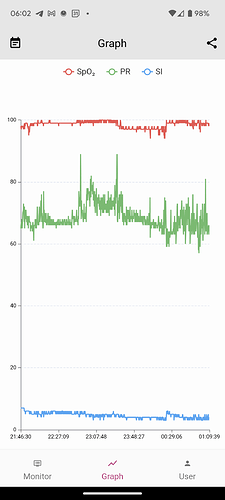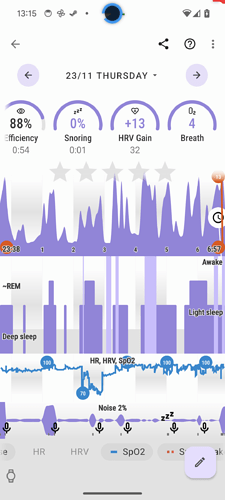I just updated to the Version 20231023 from the website (Google Play still has 20231001) and now I do not get any bio-metrics going to the app. Lots of fiddling around and not much to show for it for the TW5. Are there any watch setting that might prevent the SAA watch app from working? I have tried it with essential mode off as well to no avail.
Ok Here is an update and an important missing bit of info… After doing everything above I did not factor this issue into the mix. I wear and use a Polar H10 almost 24/7 for use with other HRV / ECG apps. I guess SAA got a bit mixed up when both of them were running at once. So I turned the H10 off and I managed to get HR and Sp02 last night from the TW5. I did not get HRV. It looks like the WearOs app updated this AM so I will see what we get tonight.
@Mark_Weiss I think you need to test this with a whole night’s data… for instance HRV is aggregated in at least 10 minutes windows to calculate SDNN and to see the data you need several values… so you really need longer periods… anyways don’t worry, I’m running every day with the watch and always get SPO2 as well as HRV data… Ideally you have the version 5.15 Wear OS app on the watch… if it does not work over night please send me a bug report and I will investigate…
Petr:
It looks like everything is working as expected now. Earlier I was testing with 15 min naps and wondering why I was not getting a full data set.
I like the TW5, but the SPO2 has an issue for me. I have it tight on my wrist but I kept getting low SPO2 alarms and the data would chart into the 70’s. I knew that is not normal for me. Last night I put on my trusty Berry Med BMA200 SPO2 meter and let it record along with the TW5. The BMA200 showed no low O2 episodes while the TW5 did. I’m going to try one more night with it cranked super tight on my wrist before I dismiss it. The whole reason I got the TW5 was due to your recommendation here. It might just be how the watch sits on my arm.
Mark
Hello Mark,
many thanks for the further feedback. I usually get quite stable SPO2 with very little divergences from the 90-100 interval… Although sometimes I also see longer drops to up to 70… IMHO this isn’t anything from with the sensor or the way we gather data from the watch, it is just that the position of the oximeter on the wrist is much more vulnerable to problematic positions of the hand e.g.: laying on the band with your head and thus limiting blood flow or laying on the watch directly or simply problematic angles of the arm etc… but the respiratory disturbance algorithm seems to be very well able to filter it and does not report some serious apnotic scores based on this…
For instance ion the picture below you see there is a drop to 70 between 2-3 but the overall respiratory disturbance index is just 4 which is in normal range…



